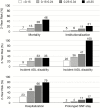Validation of a Claims-Based Frailty Index Against Physical Performance and Adverse Health Outcomes in the Health and Retirement Study
- PMID: 30165612
- PMCID: PMC6625579
- DOI: 10.1093/gerona/gly197
Validation of a Claims-Based Frailty Index Against Physical Performance and Adverse Health Outcomes in the Health and Retirement Study
Abstract
Background: A claims-based frailty index (CFI) was developed based on a deficit-accumulation approach using self-reported health information. This study aimed to independently validate the CFI against physical performance and adverse health outcomes.
Methods: This retrospective cohort study included 3,642 community-dwelling older adults who had at least 1 health care encounter in the year prior to assessments of physical performance in the 2008 Health and Retirement Study wave. A CFI was estimated from Medicare claims data in the past year. Gait speed, grip strength, and the 2-year risk of death, institutionalization, disability, hospitalization, and prolonged (>30 days) skilled nursing facility (SNF) stay were evaluated for CFI categories (robust: <0.15, prefrail: 0.15-0.24, mildly frail: 0.25-0.34, moderate-to-severely frail: ≥0.35).
Results: The prevalence of robust, prefrail, mildly frail, and moderate-to-severely frail state was 52.7%, 38.0%, 7.1%, and 2.2%, respectively. Individuals with higher CFI had lower mean gait speed (moderate-to-severely frail vs robust: 0.39 vs 0.78 m/s) and weaker grip strength (19.8 vs 28.5 kg). Higher CFI was associated with death (moderate-to-severely frail vs robust: 46% vs 7%), institutionalization (21% vs 5%), activity of daily living disability (33% vs 9%), instrumental activity of daily living disability (100% vs 22%), hospitalization (79% vs 23%), and prolonged SNF stay (17% vs 2%). The odds ratios per 1-SD (=0.07) difference in CFI were 1.46-2.06 for these outcomes, which remained statistically significant after adjustment for age, sex, and a comorbidity index.
Conclusion: The CFI is useful to identify individuals with poor physical function and at greater risks of adverse health outcomes in Medicare data.
Keywords: Frailty; Health services; Medicare claims; Physical performance.
© The Author(s) 2018. Published by Oxford University Press on behalf of The Gerontological Society of America. All rights reserved. For permissions, please e-mail: journals.permissions@oup.com.
Figures
Similar articles
-
Measuring Frailty in Medicare Data: Development and Validation of a Claims-Based Frailty Index.J Gerontol A Biol Sci Med Sci. 2018 Jun 14;73(7):980-987. doi: 10.1093/gerona/glx229. J Gerontol A Biol Sci Med Sci. 2018. PMID: 29244057 Free PMC article.
-
Measuring Frailty in Administrative Claims Data: Comparative Performance of Four Claims-Based Frailty Measures in the U.S. Medicare Data.J Gerontol A Biol Sci Med Sci. 2020 May 22;75(6):1120-1125. doi: 10.1093/gerona/glz224. J Gerontol A Biol Sci Med Sci. 2020. PMID: 31566201 Free PMC article.
-
Frailty Phenotype and Healthcare Costs and Utilization in Older Men.J Am Geriatr Soc. 2020 Sep;68(9):2034-2042. doi: 10.1111/jgs.16522. Epub 2020 May 13. J Am Geriatr Soc. 2020. PMID: 32402097 Free PMC article.
-
Effects of physical activity interventions in frail and prefrail community-dwelling people on frailty status, muscle strength, physical performance and muscle mass-a narrative review.Wien Klin Wochenschr. 2019 Jun;131(11-12):244-254. doi: 10.1007/s00508-019-1484-7. Epub 2019 Apr 2. Wien Klin Wochenschr. 2019. PMID: 30941525 Free PMC article. Review.
-
Claims-based Frailty Indices: A Systematic Review.Med Care. 2020 Sep;58(9):815-825. doi: 10.1097/MLR.0000000000001359. Med Care. 2020. PMID: 32520767
Cited by
-
Antipsychotic Medication Use Among Older Adults Following Infection-Related Hospitalization.JAMA Netw Open. 2023 Feb 1;6(2):e230063. doi: 10.1001/jamanetworkopen.2023.0063. JAMA Netw Open. 2023. PMID: 36800180 Free PMC article.
-
The Burden of Frailty Among U.S. Veterans and Its Association With Mortality, 2002-2012.J Gerontol A Biol Sci Med Sci. 2019 Jul 12;74(8):1257-1264. doi: 10.1093/gerona/gly232. J Gerontol A Biol Sci Med Sci. 2019. PMID: 30307533 Free PMC article.
-
The future of frailty: Opportunity is knocking.J Am Geriatr Soc. 2022 Jan;70(1):78-80. doi: 10.1111/jgs.17510. Epub 2021 Oct 25. J Am Geriatr Soc. 2022. PMID: 34694001 Free PMC article. No abstract available.
-
Association Between Claims-Defined Frailty and Outcomes Following 30 Versus 12 Months of Dual Antiplatelet Therapy After Percutaneous Coronary Intervention: Findings From the EXTEND-DAPT Study.J Am Heart Assoc. 2023 Jul 18;12(14):e029588. doi: 10.1161/JAHA.123.029588. Epub 2023 Jul 14. J Am Heart Assoc. 2023. PMID: 37449567 Free PMC article. Clinical Trial.
-
Frailty Is Associated with an Increased Risk of Complications and Need for Repeat Procedures after Sling Surgery in Older Adults.J Urol. 2022 Jun;207(6):1276-1284. doi: 10.1097/JU.0000000000002441. Epub 2022 Jan 21. J Urol. 2022. PMID: 35060760 Free PMC article.
References
Publication types
MeSH terms
Grants and funding
LinkOut - more resources
Full Text Sources
Other Literature Sources
Miscellaneous


